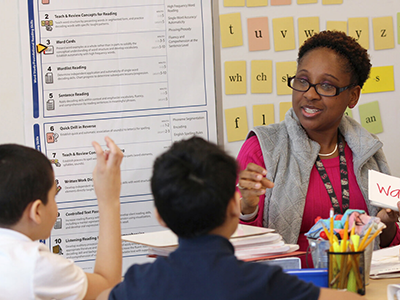Science of Reading Implementation: Strategies for Success
Watch the RecordingListen to the Podcast
While the required implementation of the Science of Reading (SOR) appears to be a phenomenon that has swept across state legislatures in recent years, the truth is that it has been a “culmination of decades of research into literacy,” according to Dr. Roland Good, a leading literacy expert who is also Co-founder of Acadience Learning and an original author of the DIBELS early literacy assessment.
Key findings of the scientific research include the necessity of teaching phonemic awareness, phonics, the alphabetic principle, fluency, vocabulary, and comprehension. Good explains that these elements are not based on “belief but on solid scientific evidence,” which means systematic and explicit instruction methods like the “I do, we do, you do” model are needed to achieve grade-level reading. He also argues that persistently low NAEP scores, particularly among diverse populations, make this an urgent issue that can be framed as the social justice issue of our time.
In the edLeader Panel “Science of Reading Implementation: Integrating Instruction and Assessment,” literacy experts and district- and school-level leaders discussed the necessary components to build successful, sustainable SOR implementations that help students achieve and even exceed grade-level proficiency standards.
Building Programs with Fidelity
Evidence-based, research-based programs have undergone rigorous measures to ensure they are scientifically sound. As such, it is imperative for these programs to be implemented with fidelity, which not only involves following the intentional design of the program but also instituting feedback loops to ensure that what is being done is working. As Good explained, fidelity involves the process of “teach a little, test a little, teach a little, test a little,” and then determining if the student is progressing along the appropriate path.
Assess, Assess, Assess
Any good SOR implementation should utilize multiple assessments. Alisa Dorman, President of Acadience Learning, explains that there are four main types of assessments that should be used throughout the year:
- Universal Screening or Benchmark Assessments: These are used three to four times throughout the year to determine a student’s starting point, mid-year progression, and year-end success.
- Progress Monitoring Assessments: These are alternate forms of measuring progress to provide a feedback loop to show how students are responding to the specific supports they’ve received.
- Diagnostic Assessments: These provide a “deeper dive” to allow educators and interventionists to create a precise plan of supports to meet the needs of specific students.
- Outcome Assessments: These provide data to show where students (or a student) are going and how to help get them to the desired goal.
What Gets Measured, Gets Done
For O’Kiyyah Lyons-Lucas, Principal of Powell Bilingual Elementary School in Washington, DC, defining specific goals and expectations is key to the successful implementation of any program, but especially a new SOR implementation because it requires administrators, teachers, intervention specialists, and parents to communicate and collaborate.
Lyons-Lucas tells her staff, “What gets measured, gets done,” and that also means removing anything that is extraneous to the mission. She tells her teachers and her staff, “If it does not align with [the goals we’ve set] we’re not putting it on your plate.” This laser-like focus on the mission circles back to implementing with fidelity—staying true to the intended design.
Collaborative Time for Teachers
Another essential component in the implementation process is ensuring teachers participate in collaborative planning sessions that are integrated into their learning process and the acquisition of tools and strategies they need to be successful.
Jason Borges, Executive Director of NYC Public Schools Literacy Collaborative, stressed that one-and-done training sessions or single workshops do not build the institutional knowledge nor allow for informational discussions that teachers need to gain insights into best practices around effective instruction and assessment. Implementation plans that integrate time for collaboration and feedback (or even go a step further and provide micro-credentialing opportunities via online or local colleges) are key to building individual teacher and schoolwide success.
Unified Approach
All panelists agreed that every successful SOR implementation begins with a unified approach that brings together administrators, educators, interventionists, and parents to address the common goal of reading proficiency for all students. The panelists offered a wealth of information on how to integrate systems (assessments and instruction) and the realistic steps of implementing a multi-year, sustainable approach.
Learn more about this edWeb broadcast, Science of Reading Implementation: Integrating Instruction and Assessment, sponsored by Wilson Language Training.
Watch the RecordingListen to the Podcast
Join the Community
ELA Today is a free professional learning community that provides educators and curriculum leaders with a place to collaborate on best practices for teaching English Language Arts in K12 today.
For more than 30 years, Wilson has advanced its vision of “Literacy for All” through multisensory structured literacy programs and professional learning backed by a commitment to the Science of Reading and implementation. The Wilson Reading System® (WRS), Fundations®, and Just Words® programs build a solid foundation for beginning readers and reduce the literacy gap for struggling students, including those with dyslexia. Wilson’s certifications result in Wilson® Dyslexia Practitioner and Therapist credentials, which have been awarded Accreditation Plus by the International Dyslexia Association (IDA). Nearly 300,000 educators have participated in Wilson courses and workshops, and 25,000 have earned WRS Level I Certification.
Article by Ginny Kirkland, based on this edLeader Panel






Comments are closed.